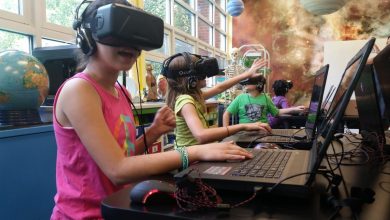Top Edtech Tools Changing The Way We Learn In 2025

Top EdTech Tools Changing the Way We Learn in 2025 exemplifies the revolutionary advancements in educational technology, promising to reshape the landscape of learning for students and educators alike. Over the past decade, we have witnessed an exponential evolution in EdTech, with tools that not only enhance learning experiences but also foster engagement and accessibility. As institutions increasingly adopt these innovations, statistics reveal a remarkable growth trajectory that underscores the significance of EdTech in modern education.
In this discussion, we will delve into groundbreaking tools that are set to transform learning in 2025, explore the integration of artificial intelligence for personalized education, and highlight the impact of gamification and immersive technologies like virtual and augmented reality. Furthermore, we will examine the crucial role of data analytics, collaboration tools, and ethical considerations in navigating this ever-evolving educational landscape.
Introduction to EdTech in 2025
The landscape of educational technology has undergone significant transformation over the past decade. The integration of digital tools in classrooms has evolved from basic computer usage to sophisticated platforms that enhance teaching and learning processes. In 2025, EdTech is no longer just an adjunct to traditional learning methods; it has become a fundamental component of the educational experience, reshaping how knowledge is imparted and acquired.
The significance of EdTech tools in enhancing the learning experiences of both students and educators cannot be overstated. These tools facilitate personalized learning, foster collaboration, and provide access to a wealth of resources that were previously unavailable. According to a recent study by HolonIQ, global EdTech investment reached approximately $20 billion in 2023, signifying a robust growth trajectory, with projections indicating that the sector could expand to over $50 billion by 2025. Such statistics illustrate the rapid adoption of technology in educational institutions, showcasing a paradigm shift where digital resources are integral to curriculum development and delivery.
Growth of EdTech Adoption in Educational Institutions, Top EdTech Tools Changing the Way We Learn in 2025
The rapid adoption of EdTech tools in educational institutions has been driven by various factors, including the need for flexible learning environments, the rise of remote education, and an increased emphasis on student-centered learning. Educational institutions are increasingly recognizing the importance of integrating technology into their curricula to meet the evolving needs of learners. The following points highlight key aspects of EdTech adoption:
- Increased Accessibility: Educational technology has made learning accessible to a broader audience, including individuals with disabilities and those in remote areas. For instance, platforms that offer online courses can reach students who may not have access to traditional educational resources.
- Engagement and Interactivity: Tools such as gamification and interactive simulations engage students more effectively. Research shows that students are more likely to retain information when they are actively involved in the learning process.
- Data-Driven Insights: EdTech tools provide educators with real-time data on student performance, enabling personalized instruction. This data empowers teachers to identify areas where students may need additional support, leading to improved outcomes.
- Collaboration Opportunities: Technology facilitates collaboration among students and educators. Online forums, group projects, and cloud-based tools allow for seamless communication and teamwork, replicating real-world collaborative environments.
- Cost-Effectiveness: Many EdTech solutions reduce costs associated with traditional educational materials. Digital textbooks, for example, can be more affordable and easily updated compared to printed versions.
Key EdTech Tools Transforming Learning
As the landscape of education evolves, certain EdTech tools are emerging as pivotal players in enhancing the learning experience for students in 2025. These tools leverage advanced technologies to facilitate personalized learning, improve engagement, and foster collaboration among learners. By integrating innovative features, they are set to transform traditional educational methods, making learning more accessible and effective.
Groundbreaking EdTech Tools
Five groundbreaking EdTech tools expected to significantly influence learning in 2025 include Adaptive Learning Platforms, Virtual Reality (VR) Learning Environments, Learning Management Systems (LMS), Gamification Tools, and Artificial Intelligence (AI) Tutors. Each of these tools provides unique features that contribute to improved educational outcomes:
- Adaptive Learning Platforms: These platforms analyze individual student learning patterns and adapt content accordingly. For example, platforms like DreamBox Learning allow personalized lesson plans that cater to each student’s progress. The unique feature is their ability to provide real-time feedback and adjust difficulty levels, which enhances student engagement and retention.
- Virtual Reality (VR) Learning Environments: VR tools such as Oculus for Business offer immersive learning experiences that transport students into simulated environments. This feature not only makes learning more engaging but also allows for experiential learning where students can practice real-life scenarios in a safe space.
- Learning Management Systems (LMS): Tools like Canvas and Moodle streamline course administration and facilitate communication between instructors and students. They provide features such as assignment tracking, interactive forums, and integrated assessments, which enhance organization and accessibility of learning materials.
- Gamification Tools: Platforms like Kahoot! and Classcraft turn learning into a game-like experience, motivating students through challenges and rewards. The unique aspect of these tools is their ability to foster competition and collaboration, making the learning process more enjoyable and effective.
- Artificial Intelligence (AI) Tutors: AI-driven tutoring systems such as Carnegie Learning provide tailored support to students based on their unique needs. These tools utilize machine learning algorithms to identify knowledge gaps and deliver personalized instruction, which helps in improving learning outcomes significantly.
Comparison of EdTech Tools
The following table highlights the pros and cons of each tool, providing a clear comparison to understand their impact on learning effectively.
| Tool | Pros | Cons |
|---|---|---|
| Adaptive Learning Platforms |
|
|
| Virtual Reality Learning Environments |
|
|
| Learning Management Systems |
|
|
| Gamification Tools |
|
|
| Artificial Intelligence Tutors |
|
|
The Role of Artificial Intelligence in Education
The integration of artificial intelligence (AI) in education is reshaping the landscape of learning and teaching. As we progress through 2025, AI is increasingly leveraged to offer personalized learning experiences that cater to the unique needs of each student. This transformation not only enhances engagement but also improves the efficacy of educational methodologies. AI tools are streamlining administrative tasks, aiding in content curation, and providing insights into student performance, thus allowing educators to focus more on teaching and mentoring.
AI technologies are being integrated into various EdTech tools, driving personalized learning experiences that adapt to individual learning paces and styles. These tools analyze student data to curate content that aligns with students’ strengths and weaknesses, thus fostering a tailored educational experience. As a result, educators can identify learning gaps and intervene effectively, while students benefit from a learning pathway that resonates with their specific requirements.
Examples of AI-powered Educational Platforms
Several platforms exemplify the use of AI in creating efficient and personalized educational experiences. These tools harness machine learning algorithms and data analytics to enhance learning outcomes. Notable examples include:
- Knewton: This adaptive learning platform uses AI to deliver personalized content and assessments to students. By analyzing data from student interactions, Knewton tailors educational resources according to individual learning styles and progress levels.
- Duolingo: Known for language learning, Duolingo employs AI to adapt lessons based on user performance. Its algorithms analyze a user’s strengths and weaknesses and adjust the difficulty of exercises accordingly, ensuring a customized learning journey.
- DreamBox Learning: An innovative math platform that utilizes AI to create personalized learning experiences for K-8 students. It analyzes student responses in real-time to provide immediate feedback and adapt the curriculum to suit their learning needs.
- IBM Watson Education: This platform offers AI-driven insights to educators, helping them make data-informed decisions. By analyzing student data, it provides recommendations on resources and interventions that can support student success.
The future of AI in the EdTech space holds promising developments that can further enhance learning environments. As AI technologies advance, we may witness more sophisticated systems capable of simulating human-like responses, thereby providing even more interactive and engaging learning experiences. The potential for fully AI-driven tutoring systems, virtual reality classrooms, and predictive analytics in student performance are poised to transform education even further. By continually refining algorithms and expanding data sets, AI could also facilitate a greater understanding of diverse learning needs, resulting in equitable educational access for all students.
“AI in education is not just about automating tasks; it is fundamentally reshaping how we think about learning.”
Gamification and Interactive Learning
Gamification in education has emerged as a transformative approach that integrates game mechanics into the learning environment. This strategy not only enhances student engagement but also fosters motivation and a deeper connection with the learning material. By leveraging the inherent appeal of games, educators can create dynamic and interactive experiences that resonate with learners of all ages.
The principles of gamification in education revolve around several key concepts that promote active learning. These include the incorporation of elements such as points, badges, leaderboards, and challenges, all designed to motivate students and encourage friendly competition. By providing immediate feedback and rewards for progress, gamification creates a sense of achievement and enhances the learning experience. Furthermore, it encourages collaboration among peers, leading to a more immersive and interactive learning atmosphere.
Engagement and Retention through Interactive Learning Tools
Interactive learning tools are pivotal in creating engaging educational experiences that significantly improve retention rates among students. These tools foster active participation and make learning enjoyable, leading to better comprehension and memory retention. The implementation of technology in the classroom, such as educational games, simulations, and interactive quizzes, allows students to actively engage with the content rather than passively consuming it.
The effectiveness of these tools can be illustrated through various successful case studies that showcase the impact of gamification in educational settings. Below is a list of notable examples that demonstrate how gamification has transformed learning experiences in classrooms:
- Kahoot: A game-based learning platform that allows educators to create quizzes, fostering competition and collaboration among students. Studies show that teachers who utilize Kahoot report increased student engagement and improved test scores.
- Classcraft: An educational role-playing game that encourages teamwork and positive behavior through gamified learning experiences. Schools that have implemented Classcraft have observed enhanced student motivation and a decrease in disruptive behavior.
- Scratch: A programming language and online community where students can create interactive stories, games, and animations. Research indicates that students using Scratch demonstrate increased creativity and problem-solving skills, with improved learning outcomes in computer science.
- Duolingo: A language-learning platform that incorporates gamification elements like levels, rewards, and streaks. Users report higher retention rates and a more enjoyable learning process compared to traditional language courses.
These case studies highlight the significant positive outcomes associated with gamification and interactive learning tools in educational settings. By integrating these approaches, educators can create a more engaging and effective learning environment that resonates with today’s tech-savvy students.
Virtual and Augmented Reality in Education
The integration of Virtual Reality (VR) and Augmented Reality (AR) into education is transforming traditional learning environments, providing students with immersive experiences that enhance engagement and understanding. By simulating real-world scenarios or enhancing physical spaces with digital information, these technologies offer innovative ways to deliver content and foster skills needed for the future.
The applications of VR and AR in education are numerous and varied, impacting subjects such as science, history, and the arts. These technologies allow learners to engage with content in a more interactive manner, which can lead to improved retention and comprehension. For instance, in a science class, students can explore the human body in a 3D environment, observe biological processes up close, and even manipulate virtual organs to understand their functions better. Similarly, in history lessons, students can take virtual field trips to ancient civilizations or significant historical events, providing a deeper connection to the material.
Examples of VR and AR Tools in Education
Numerous VR and AR tools have emerged, each designed to facilitate unique learning experiences. Their specific educational use cases showcase how these technologies can be effectively integrated into various curricula:
- Google Expeditions: This tool allows educators to take students on virtual field trips around the world. With VR headsets, learners can explore the Great Barrier Reef or walk through ancient ruins, enriching their understanding of diverse cultures and environments.
- zSpace: zSpace provides an interactive learning experience by allowing students to visualize and interact with 3D models in real time. This tool is particularly beneficial in STEM education, enabling students to conduct virtual experiments or explore complex scientific concepts.
- Merge Cube: This AR tool allows students to hold a cube that, when viewed through a compatible device, reveals interactive holograms. It is used in various subjects, from biology to mathematics, providing students with hands-on learning experiences that can enhance their understanding of abstract concepts.
- ClassVR: ClassVR offers educators a comprehensive platform to deliver immersive learning experiences. Teachers can choose from a vast library of VR content or create their own, making it suitable for various subjects and grade levels. This flexibility allows for tailored educational experiences that meet the specific needs of students.
The implementation of VR and AR in educational settings, while promising, does face several challenges and limitations. These include:
- Cost: The expense associated with acquiring VR and AR equipment can be prohibitive for many educational institutions, particularly those with limited budgets.
- Training and Support: Educators may require extensive training to effectively integrate these technologies into their teaching practices. Without adequate support, the potential benefits of VR and AR can be underutilized.
- Technical Limitations: Issues such as software compatibility, hardware requirements, and the need for reliable internet connectivity can hinder the widespread adoption of these technologies in classrooms.
- Physical Space and Safety Concerns: The use of VR often necessitates a designated physical space, and there are concerns regarding student safety while using immersive technologies, particularly in terms of physical movement and potential disorientation.
“The potential of VR and AR in education lies not only in what they can show but in how they can transform learning into an engaging and interactive experience.”
The Importance of Data Analytics in Education
Data analytics plays a crucial role in modern education by enabling educators to track student performance effectively and enhance learning outcomes. Through various analytical tools, educators can gain insights into students’ academic progress, identify learning gaps, and tailor instructional strategies to meet diverse needs. This data-driven approach not only improves individual student performance but also enhances overall classroom dynamics and school effectiveness.
Effective tracking of student performance is facilitated by data analytics, which provides educators with the ability to compile and analyze vast amounts of information. By utilizing data on student assessments, attendance, engagement levels, and demographic factors, educators can make informed decisions that drive student success. For instance, analytics can reveal patterns that indicate which teaching methods are most effective for different groups of students, thereby allowing for personalized learning experiences.
Analytics Tools Assisting Educators
A variety of analytics tools are available to educators, each designed to assist in making data-driven decisions. The following examples illustrate how these tools can enhance educational practices:
- Learning Management Systems (LMS): Platforms such as Canvas and Moodle provide integrated analytics dashboards that track student engagement, assignment completion, and assessment results. These metrics help educators to identify at-risk students promptly.
- Data Visualization Tools: Tools like Tableau and Google Data Studio allow educators to visualize complex data sets, making trends and patterns more accessible. This helps in presenting data in a comprehensible format for stakeholders.
- Predictive Analytics Software: Programs like Civitas Learning use predictive models to forecast student outcomes, enabling institutions to allocate resources effectively and implement early intervention strategies.
The significance of these tools lies in their capacity to transform raw data into actionable insights that can substantially impact teaching and learning processes.
Future Trends in Educational Analytics
The future of educational analytics is poised for significant advancements that will transform teaching strategies and enhance student learning experiences. Several key trends are emerging in this field:
- Real-Time Analytics: The use of real-time data analytics will enable educators to respond immediately to student needs, facilitating timely interventions that can prevent academic decline.
- Integration of Artificial Intelligence: With AI-driven analytics, educators will gain deeper insights into student behaviors and learning patterns, paving the way for personalized learning pathways that adapt in real-time.
- Increased Focus on Predictive Analysis: Educational institutions are likely to adopt more sophisticated predictive analytics tools to anticipate student performance and retention rates, allowing for strategic planning and resource allocation.
- Enhanced Data Privacy Measures: As data usage grows, there will be a greater emphasis on protecting student privacy and ensuring compliance with regulations, leading to more secure data practices.
These trends indicate a shift towards a more data-centric educational landscape, where data analytics will play an indispensable role in shaping effective teaching strategies and improving student outcomes.
Collaboration and Communication Tools for Educators
The landscape of education is continually evolving, and the emergence of collaboration and communication tools is pivotal in transforming the way educators and students interact. These platforms have become essential for fostering teamwork, enhancing engagement, and streamlining communication within the learning environment. As we move into 2025, several tools stand out for their ability to facilitate effective collaboration among teachers and students, ultimately enriching the educational experience.
Effective collaboration platforms are designed with features that cater to the unique needs of educational settings. They enable seamless communication, resource sharing, and coordination among teams, which are critical components of modern education. Below is a comparison of key collaboration tools, highlighting their unique functionalities and features that enhance teamwork in learning environments.
Key Collaboration Platforms
Several collaboration platforms have gained prominence in education due to their innovative features. The following tools are noteworthy:
| Platform | Key Features | Unique Functionalities |
|---|---|---|
| Google Workspace for Education |
| Allows educators to create collaborative environments with shared drives and integrated communication via Google Meet. |
| Microsoft Teams for Education |
| Facilitates classrooms where educators can post assignments, feedback, and conduct discussions all in one platform. |
| Slack |
| Offers a flexible space for discussions, allowing educators to create channels for different projects or class discussions. |
| Padlet |
| Encourages creativity and collaborative brainstorming through visual presentations of ideas and projects. |
Incorporating these collaboration tools into the educational framework not only enhances communication among educators and students but also encourages a spirit of teamwork and collaboration. By leveraging these innovative platforms, educators can create dynamic learning environments that support collaborative projects, improve communication, and facilitate a more engaging educational experience for all participants.
“The right collaboration tools can transform a classroom into a vibrant learning community where ideas flourish and teamwork thrives.”
The Future of Remote Learning
The evolution of remote learning tools has dramatically transformed the educational landscape, making learning more accessible than ever before. With advancements in technology, students from diverse backgrounds can engage in high-quality education regardless of geographical barriers. The continued development of these tools is essential in ensuring that education remains equitable and inclusive as we move further into the digital age.
Remote learning environments have presented unique challenges, particularly in maintaining student engagement. It is crucial to cultivate an atmosphere that encourages interaction and participation among learners. Engaged students are more likely to absorb information and develop a deeper understanding of the material being taught. Educators play a vital role in fostering this engagement by utilizing innovative strategies and technologies.
Best Practices for Fostering Productive Online Learning Experiences
To create an effective remote learning environment, educators should adopt various best practices that enhance engagement and facilitate learning. The following strategies have proven to be beneficial:
1. Incorporate Interactive Content: Utilizing interactive tools such as quizzes, polls, and virtual breakout rooms can stimulate participation. Engaging students through gamified elements and collaborative projects fosters a sense of community and keeps learners focused.
2. Establish Clear Communication Channels: Consistent communication is key to remote learning success. Educators should encourage open dialogue through forums, chat platforms, and regular check-ins to address student concerns and facilitate discussions.
3. Utilize Multimedia Resources: The incorporation of videos, infographics, and podcasts can cater to different learning styles and keep the material fresh and interesting. Diverse formats can aid in maintaining student attention and enhancing comprehension.
4. Set Structured Schedules: Clear and consistent schedules help students manage their time effectively. Establishing regular class times and deadlines can provide a sense of routine, which is essential for learning.
5. Offer Personalized Support: Tailoring support to meet individual needs can significantly enhance student learning experiences. Providing opportunities for one-on-one sessions or small group meetings allows educators to address specific challenges faced by learners.
6. Encourage Peer Collaboration: Group projects and peer feedback initiatives can foster collaboration, promoting a sense of belonging among students. By working together, students can enhance their understanding of concepts and build valuable interpersonal skills.
7. Gather Feedback Regularly: Continuous feedback from students can provide insights into their learning experiences and highlight areas for improvement. Implementing anonymous surveys can encourage honest communication about what works and what does not.
By embracing these best practices, educators can significantly enhance the remote learning experience, ultimately leading to a more productive and enriching educational environment for students.
Ethical Considerations in EdTech: Top EdTech Tools Changing The Way We Learn In 2025
In the rapidly evolving landscape of educational technology (EdTech), ethical considerations have emerged as critical components in ensuring that advancements in digital learning do not come at the expense of students’ rights and well-being. As educational institutions increasingly integrate technology into their curricula, it is essential to address potential ethical concerns that may arise, particularly concerning data privacy, security, and the overall impact of these tools on learning environments.
The integration of technology in education has introduced various ethical challenges. These challenges stem from the increased reliance on data-driven decision-making, the accessibility of personal information, and the implications of AI-driven tools in the classroom. It is imperative to consider how these factors influence not only the learning experience but also the trust and relationship between educators, students, and parents.
Potential Ethical Concerns Related to Technology in Education
Several ethical issues are pertinent when discussing the deployment of technology in educational settings. These concerns include:
- Data Privacy: The collection and storage of sensitive student information raise significant privacy issues. Schools must ensure compliance with regulations like FERPA (Family Educational Rights and Privacy Act) and GDPR (General Data Protection Regulation) to protect students’ personal data.
- Security Risks: The potential for data breaches and unauthorized access to sensitive information can compromise the security of student data, making it essential for institutions to implement robust cybersecurity measures.
- Digital Equity: The disparity in access to technology can exacerbate existing inequalities among students, highlighting the need for equitable access to EdTech resources.
- Bias in AI Algorithms: The use of AI tools in education raises concerns about the potential for bias in data processing, which can affect educational outcomes for underrepresented groups.
Importance of Data Privacy and Security in EdTech Applications
Data privacy and security are paramount in the realm of EdTech, as educational institutions collect vast amounts of personal information from students and educators. This data may include academic records, behavioral patterns, and demographic information. Failure to protect this data can have serious repercussions, both legally and ethically.
Educational institutions must prioritize data protection measures, ensuring that all EdTech applications adhere to stringent privacy standards. This involves regular audits of data management practices, training staff on data security protocols, and being transparent with parents and students about how their data is used and stored.
Recommendations for Educators to Address Ethical Challenges in EdTech
It is essential for educators to actively engage with the ethical implications of EdTech. Here are several recommendations to address these challenges:
- Conduct Regular Training: Educators should receive training on ethical practices in technology use, focusing on data privacy, security, and digital citizenship.
- Implement Clear Policies: Establish clear policies regarding data usage, consent, and communication that align with ethical standards and legal requirements.
- Engage Stakeholders: Involve students, parents, and the community in discussions about the use of technology in education, fostering transparency and trust.
- Monitor and Evaluate: Continuously assess the effectiveness and ethical implications of EdTech tools and make necessary adjustments based on feedback and evolving standards.
“Ethical considerations in EdTech are not just about compliance with laws; they are about fostering a safe and equitable learning environment for all students.”
Preparing for the Future of Learning
As education continues to evolve, it is imperative for educators and institutions to remain agile and responsive to advancements in Educational Technology (EdTech). The landscape of learning is shaped by rapid technological changes, thus necessitating a proactive approach to ensure that educational practices align with these developments. Institutions must adopt actionable strategies that promote adaptability, continuous professional development, and a culture of innovation to thrive in this dynamic environment.
A pivotal aspect of preparing for the future involves implementing strategies that empower educators to embrace EdTech. Institutions should prioritize access to resources and training that facilitate the integration of new technologies into the curriculum. As these tools develop, incorporating them into everyday teaching practices will enhance student engagement and learning outcomes.
Actionable Strategies for Educators and Institutions
Establishing a framework for continuous improvement in EdTech integration requires a multi-faceted approach. The following strategies can aid educators and institutions in fostering adaptability:
- Invest in comprehensive training programs that equip teachers with the necessary skills to utilize emerging technologies effectively.
- Encourage collaboration among educators to share best practices and insights on technology implementation.
- Foster partnerships with EdTech companies to stay informed about the latest innovations and tools available for education.
- Continuously evaluate and adapt the curriculum to incorporate new technologies that enhance learning experiences.
- Utilize feedback from students and educators to refine technology use and identify areas for improvement.
The significance of ongoing professional development cannot be overstated in the context of EdTech. Educators should engage in learning opportunities that expand their understanding of technological advancements and their applications in the classroom.
Continuous Professional Development in Educational Technology
To sustain proficiency in the ever-evolving realm of EdTech, continuous professional development is essential. Educators must actively seek opportunities to enhance their skills and knowledge, ensuring they remain at the forefront of educational innovation.
“Continuous professional development is vital for educators to effectively harness the potential of EdTech tools.”
Professional development activities can take various forms, including workshops, online courses, and conferences. These not only provide educators with the latest information but also facilitate networking with peers and EdTech professionals. Institutions should allocate resources and time for educators to participate in these initiatives, ultimately leading to improved teaching practices and student outcomes.
Cultivating a Culture of Innovation
Creating an environment that encourages innovation is critical for educational organizations aiming to adapt to future learning needs. A culture of innovation fosters creativity, experimentation, and collaboration among educators and students.
Institutions can promote this culture by:
- Encouraging risk-taking and the trial of new ideas related to technology integration.
- Providing platforms for educators to share innovative practices and results.
- Recognizing and rewarding innovative teaching practices that enhance learning.
- Facilitating regular brainstorming sessions where educators can discuss potential innovations in their teaching methodologies.
- Involving students in the decision-making process regarding technology use to ensure their needs and preferences are met.
By embedding innovation into the educational framework, institutions can ensure they remain relevant and effective in meeting the evolving demands of learners in the 21st century. Through strategic planning, professional development, and a focus on innovation, educators and institutions will be well-prepared to navigate the future of learning.
Ending Remarks
In conclusion, the emergence of Top EdTech Tools Changing the Way We Learn in 2025 represents a pivotal shift in educational practices, fostering innovative approaches to teaching and learning. As we look forward to a future enriched by technology, it is essential for educators and institutions to embrace these advancements, ensuring they are well-equipped to adapt and thrive. By remaining proactive, inclusive, and ethical in our approach, we can harness the full potential of EdTech to create more effective and engaging learning environments for all.
FAQ
What are EdTech tools?
EdTech tools are technologies used to facilitate and enhance learning experiences in educational settings, including software, applications, and online platforms.
How can EdTech tools benefit educators?
These tools can streamline lesson planning, facilitate collaboration, and provide valuable insights through data analytics, ultimately enhancing teaching effectiveness.
What role does AI play in EdTech?
AI is used in EdTech to personalize learning experiences, adapt content to individual student needs, and provide automated feedback, making education more efficient and tailored.
Are there any challenges with implementing EdTech tools?
Challenges include ensuring data privacy, addressing the digital divide, and providing adequate training for educators to effectively integrate these tools into their teaching practices.
How do gamification elements improve learning?
Gamification elements enhance engagement and motivation among students by incorporating game-like features, which can lead to increased retention and a more enjoyable learning experience.







